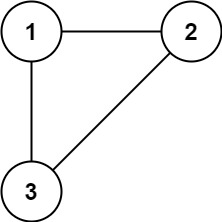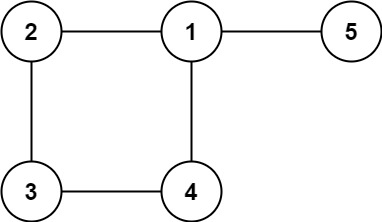684. Redundant Connection
Description
In this problem, a tree is an undirected graph that is connected and has no cycles.
You are given a graph that started as a tree with n nodes labeled from 1 to n, with one additional edge added. The added edge has two different vertices chosen from 1 to n, and was not an edge that already existed. The graph is represented as an array edges of length n where edges[i] = [ai, bi] indicates that there is an edge between nodes ai and bi in the graph.
Return an edge that can be removed so that the resulting graph is a tree of n nodes. If there are multiple answers, return the answer that occurs last in the input.
Example 1:

Input: edges = [[1,2],[1,3],[2,3]] Output: [2,3]
Example 2:

Input: edges = [[1,2],[2,3],[3,4],[1,4],[1,5]] Output: [1,4]
Constraints:
n == edges.length3 <= n <= 1000edges[i].length == 21 <= ai < bi <= edges.lengthai != bi- There are no repeated edges.
- The given graph is connected.
Solutions
Solution: Union Find
- Time complexity: O(n)
- Space complexity: O(n)
JavaScript
js
/**
* @param {number[][]} edges
* @return {number[]}
*/
const findRedundantConnection = function (edges) {
const n = edges.length;
const groups = Array.from({ length: n + 1 }, (_, index) => index);
const ranks = Array.from({ length: n + 1 }, () => 1);
const find = node => {
const group = groups[node];
return group === node ? node : find(group);
};
const union = (a, b) => {
const x = find(a);
const y = find(b);
if (x === y) return false;
if (ranks[x] > ranks[y]) {
groups[y] = x;
} else if (ranks[x] < ranks[y]) {
groups[x] = y;
} else {
groups[y] = x;
ranks[x] += 1;
}
return true;
};
for (const [a, b] of edges) {
if (!union(a, b)) return [a, b];
}
return [];
};